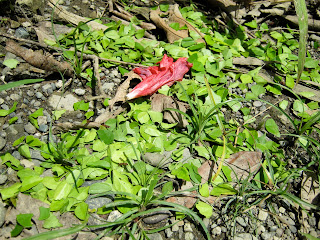Thursday, November 10, 2011
The Leafcutters
Every time I tell someone about leafcutters, I have a captive audience. I don't even need the pictures to showcase these amazing animals' talents. I'd read about them when I was young, but didn't truly appreciate what they do until much later, probably around the time I was in college.
I got to see them in person for only the second time in my life a few months ago, during a trip to Costa Rica. The first was on a trip to Brazil with my family when I was thirteen. I didn't even think to take pictures then. This time I knew better.
These leafcutters had a nest within a five minute walk of the hotel where my wife and I stayed, near some houses and open land. I can't imagine the locals having any problems with the ants; a leafcutter ant in your house is lost.
So, what makes leafcutters so special? I can sum it up in two words: they farm.
You may have heard of other ants who "milk" aphids for a sweet secretion called honeydew, and these aphids are often called antcows because of that relationship. The aphids spend all day sucking up plant juice, which is rich in water and sugar, but is a poor source of other vital nutrients. So they excrete the excess sugar water, which some ants lap up happily. These ants often protect the aphids in a kind of shepherding behavior, but leafcutters take farming behavior to another level.
If you see them in the wild, this is what you probably see first:
The picture didn't come out well because I have a cheap camera and these ants are fast. Even the ones holding those leaf bits are moving at a frantic pace.
These are the ants carrying leaves back to their nest, and other ants are rushing out from the nest to collect more. These paths can go dozens of feet from the nest to the leaf collecting site.
If you follow the unladen ants, you may spot something like this:
These piles of leaf bits was found along the ant trail, and some ants heading to the site simply came to this pile, took a leaf, and headed back. This is a sign to look up, and in the bushes, I saw this:
Here we see the ants at work. These leaves are being trimmed down to nearly nothing by the ants, in a methodical group effort. They don't usually kill the plants they take leaves from, however. Every day, they take new paths to new collecting sites, allowing the foliage time to recover until they return.
How they collect the leaves is an interesting process. Leafcutters, like many ants, have different "castes" of workers, usually differing mainly in size, from small, nest-bound workers, to large, powerful soldiers. Leafcutters have several different castes in between, but in general, only the largest castes go out to collect leaves. The largest workers are needed to do the heavy cutting work.
That worker ant in the center is showcasing the heavy duty equipment required for cutting the leaves into manageable chunks: two massive, sharp, and powerful mandibles. Notice the ant just to the left of center, using one mandible to anchor her head to the leaf while the other slices from right to left. You can see the circular cut she's making starting from the bottom of the leaf.
When the ant finishes her cut, she will either carry it back to the nest or drop it on the trail to keep cutting. The largest workers can work much more efficiently if they stick to cutting, and let smaller ants carry their pieces back to the nest.
So far, this doesn't look like farming, just gathering. But leafcutter ants don't eat leaves. All of this work has a greater, hidden purpose. Leafcutters will take this leaf bits back to their nest, and workers at the nest will chop up the bits into smaller and smaller pieces. Finally, the smallest workers will take the smallest bits and chew them up into a paste. They take the paste to special, climate-controlled chambers in the nest where a fungus grows on the walls. The workers then smear the leaf paste over the walls of the chamber, and the fungus grows on the paste. Finally, the ants eat the fungus.
To reiterate: leafcutter ants eat a fungus that grows inside their nest, and they feed it chewed-up leaves. The fungus could not exist without the ants, and in fact are not found anywhere else in the world. The ants, similarly, would starve without their fungal food. In addition, there are many different species of leafcutter ants throughout the Americas, mostly in tropical regions, and most, if not all, have their own unique fungus.
These ants have been farming their fungus food for millions of years, long before humans existed, much less developed our own farming techniques. And yet, they do it entirely by instinct. They have no methods for researching more efficient techniques. Only evolution, through trial and error (the errors are dead ants), can drive any changes in their behavior.
Up here in the northern latitudes, we don't see many leafcutter ants. The fungus they eat tends to die out in cold winter weather. At least one species has adapted to chillier temperatures, and it can be found in the United States, mostly in Texas, but I've heard dubious reports of leafcutters found in the northeastern U.S., as well.
For more on leafcutter ants, check out Wikipedia's take on the leafcutter, and Mark Moffet's book, Adventures Among Ants (I checked it out from the Albuquerque Public Library, if your library doesn't have it, it should), which also discusses several other tropical ant lifestyles.
---
All pictures by Robert Stewart-Rogers, 2011
Subscribe to:
Post Comments (Atom)





No comments:
Post a Comment